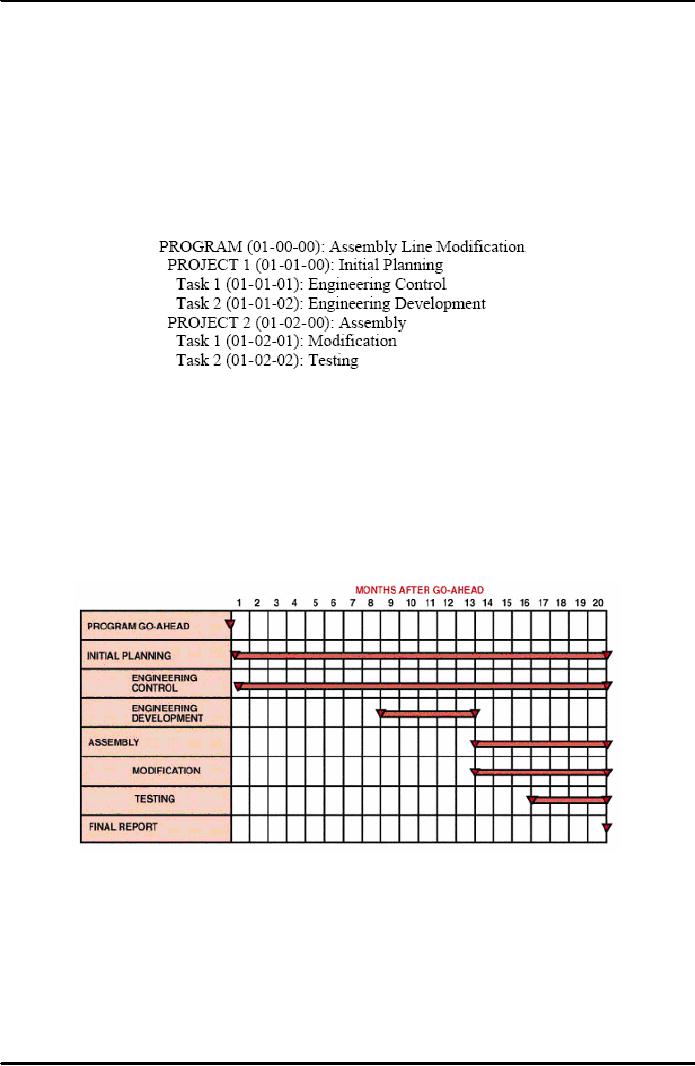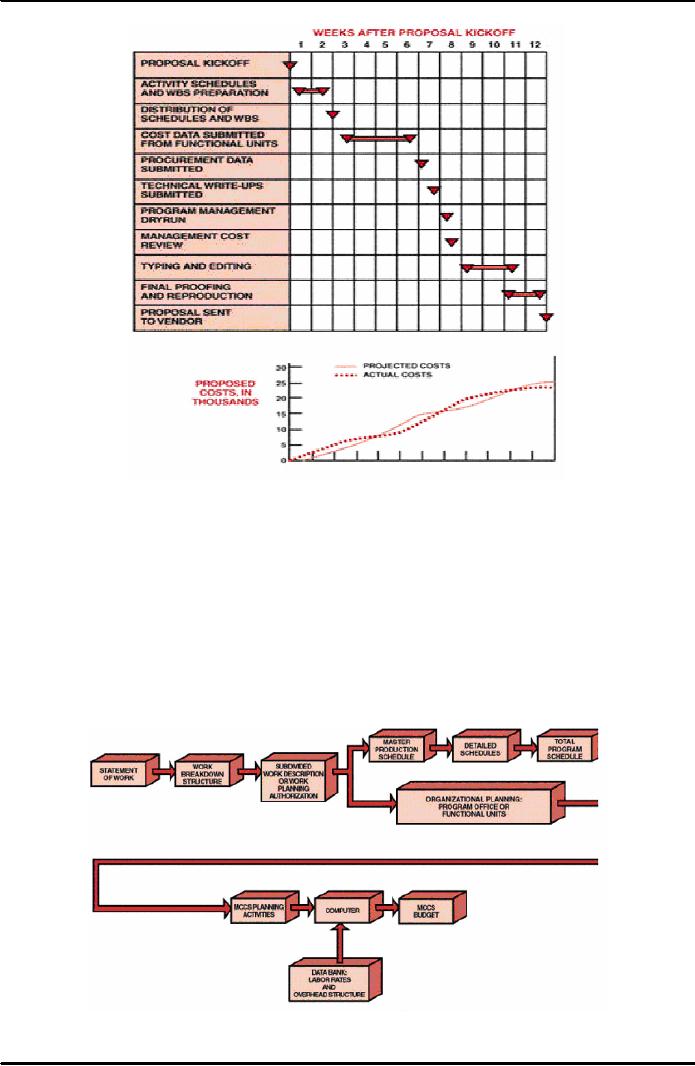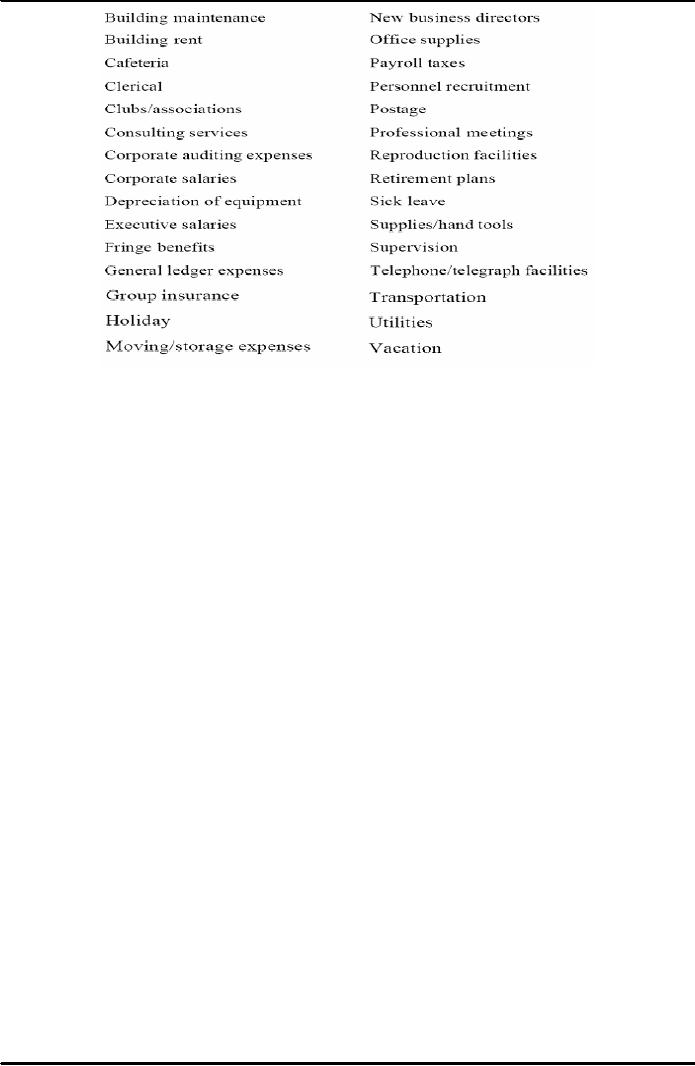 |

Project
Management MGMT627
VU
LESSON
32
PRICING
AND ESTIMATION (CONTD.)
BROAD
CONTENTS
Organizational
Input Requirements
Labor
Distributions
Overhead
Costs
32.1
ORGANIZATIONAL
INPUT REQUIREMENTS:
Note
that once the work breakdown
structure and activity schedules are
established, the
program
manager calls a meeting for
all organizations that will
be required to submit
pricing
information.
It is imperative that all
pricing or labor-costing representatives be
present for the
first
meeting. During this
''kickoff" meeting, the work
breakdown structure is described in
depth
so
that each pricing unit
manager will know exactly
what his responsibilities
are during the
program.
The kickoff meeting also
resolves the struggle-for-power positions
of several
functional
managers whose responsibilities
may be similar to overlap on
certain activities. An
example
of this would be quality
control activities. During the
research and development
phase
of
a program, research personnel may be
permitted to perform their
own quality control
efforts,
whereas
during production activities the
quality control department or division
would have
overall
responsibility. Unfortunately, one
meeting is not always
sufficient to clarify
all
problems.
Follow-up or status meetings are
held, normally with only
those parties concerned
with
the problems that have arisen. Some
companies prefer to have all
members attend the
status
meetings so that all personnel will be
familiar with the total
effort and the
associated
problems.
The advantage of not having
all program-related personnel attend is
that time is of the
essence
when pricing out activities.
Many functional divisions
carry this policy one step
further
by
having a divisional representative
together with possibly key
department managers or section
supervisors
as the only attendees at the
kickoff meeting. The
divisional representative then
assumes
all responsibility for
assuring that all costing
data are submitted on time.
This
arrangement
may be beneficial in that the
program office need contact
only one individual
in
the
division to learn of the activity
status, but it may become a
bottleneck if the representative
fails
to maintain proper communication between
the functional units and the program
office, or
if
the individual simply is unfamiliar
with the pricing requirements of the work
breakdown
structure.
Time
may be extremely important,
during proposal activities.
There are many situations
in
which
a Request for Proposal (RFP) requires
that all responders submit
their bids no later than
a
specific
date, say within thirty
days. Under a proposal
environment, the activities of the
program
office, as well as those of the
functional units, are under
a schedule set forth by
the
proposal
manager. The proposal manager's
schedule has very little, if
any, flexibility and is
normally
under tight time constraints so
that the proposal may be
typed, edited, and
published
prior
to the date of submittal. In this
case, the Request for Proposal (RFP)
will indirectly
define
how
much time the pricing units
have to identify and justify labor
costs.
The
justification of the labor costs
may take longer than the
original cost estimates,
especially if
historical
standards are not available.
Many proposals often require
that comprehensive labor
justification
be submitted. Other proposals, especially
those that request an almost
immediate
response,
may permit vendors to submit
labor justification at a later
date.
Remember
that in the final analysis, it is the
responsibility of the lowest pricing
unit supervisors
to
maintain adequate standards, if possible,
so that an almost immediate response
can be given
to
a pricing request from a
program office.
232

Project
Management MGMT627
VU
32.2
LABOR
DISTRIBUTIONS:
The
functional units supply
their input to the program
office in the form of man-hours as
shown
in
Figure 32.1 below.
Figure
32.1: Functional
Pricing Flow
The
input may be accompanied by
labor justification, if required.
The man-hours are
submitted
for
each task, assuming that the
task is the lowest pricing element,
and are time-phased per
month.
The man-hours per month per task
are converted to dollars
after multiplication by the
appropriate
labor rates. The labor
rates are generally known
with certainty over a
twelve-month
period,
but from then on are
only estimates. How can a
company predict salary structures
five
years
hence? If the company underestimates the salary
structure, increased costs and
decreased
profits
will occur. If the salary structure is overestimated,
the company may not be
competitive;
if
the project is government funded,
then the salary structure becomes an item
under contract
negotiations.
In
this regard, the development of the labor
rates to be used in the projection is
based on
historical
costs in business base hours and
dollars for the most recent
month or quarter.
Average
hourly
rates are determined for
each labor unit by direct
effort within the operations at
the
department
level. The rates are
only averages, and include
both the highest-paid employees
and
lowest-paid
employees, together with the department
manager and the clerical support.
These
base
rates are then escalated as
a percentage factor based on
past experience, budget as
approved
by management, and the local outlook
and similar industries. If the company
has a
predominant
aerospace or defense industry
business base, then these
salaries are negotiated
with
local
government agencies prior to
submittal for proposals.
The
labor hours submitted by the functional
units are quite often
overestimated for fear
that
management
will "massage" and reduce the
labor hours while attempting to
maintain the same
scope
of effort. Many times management is
forced to reduce man-hours either
because of
insufficient
funding or just to remain
competitive in the environment. The
reduction of man-
hours
often causes heated
discussions between the functional and
program managers. Program
managers
tend to think in terms of the
best interests of the program,
whereas functional
managers
lean toward maintaining
their present staff.
To
cater to this, the most common
solution to this conflict
rests with the program manager.
If
the
program manager selects
members for the program team
who are knowledgeable in
man-
hour
standards for each of the
departments, then an atmosphere of trust
can develop between the
program
office and the functional department so
that man-hours can be reduced in a
manner that
233

Project
Management MGMT627
VU
represents
the best interests of the company.
This is one of the reasons
why program team
members
are often promoted from
within the functional ranks.
The
man-hours submitted by the functional
units provide the basis for
total program cost
analysis
and program cost control. To
illustrate this process, consider the
following Example
32.1:
Example
32.1:
On
May 15, Apex Manufacturing decided to
enter into competitive bidding
for the modification
and
updating of an assembly line
program. A work breakdown structure
was developed as
shown
below:
On
June 1, each pricing unit
was given the work breakdown
structure together with the
schedule
as
shown in Figure 32.2 below.
According to the schedule developed by
the proposal manager
for
this project, all labor
data must be submitted to
the program office for
review no later than
June
15. It should be noted here
that, in many companies,
labor hours are submitted
directly to
the
pricing department for submittal
into the base case computer
run. In this case, the
program
office
would "massage" the labor hours
only after the base case
figures are available.
This
procedure
assumes that sufficient time
exists for analysis and modification of
the base case. If
the
program office has
sufficient personnel capable of critiquing the
labor input prior to
submittal
to the base case, then
valuable time can be saved,
especially if two or three days
are
required
to obtain computer output for the
base case.
Figure
32.2: Activity
Schedule for Assembly Line
Updating
Note
that during proposal
activities, the proposal manager, pricing
manager, and program
manager
must all work together,
although the program manager
has the final say. The
primary
responsibility
of the proposal manager is to integrate
the proposal activities into the
operational
system
so that the proposal will be
submitted to the requestor on time. A
typical schedule
developed
by the proposal manager is shown in
Figure 32.3 below. The
schedule includes all
activities
necessary to "get the proposal
out of the house," with the
first major step being
the
submittal
of man-hours by the pricing organizations. It
also indicates the tracking of
proposal
costs.
The proposal activity
schedule is usually accompanied by a
time schedule with a
detailed
estimates
checklist if the complexity of the
proposal warrants one.
234

Project
Management MGMT627
VU
Figure
32.3: Proposal
Activity Schedule
The
checklist generally provides
detailed explanations for the
proposal activity
schedule.
After
the planning and pricing charts
are approved by program team
members and program
managers,
they are entered into an
Electronic Data Processing (EDP)
system as shown in Figure
32.4
below. The computer then
prices the hours on the planning charts
using the applicable
department
rates for preparation of the
direct budget time plan and
estimate-at-completion
reports.
The direct budget time
plan reports, once established, remain
the same for the life of
the
contract
except for customer directed or
approved changes or when
contractor management
determines
that a reduction in budget is
advisable. However, if a budget is
reduced by
management,
it cannot be increased without customer
approval.
Figure
32.4: Labor
Planning Flow Chart
235

Project
Management MGMT627
VU
In
addition, the time plan is
normally a monthly mechanical printout of
all planned effort by
work
package and organizational element over
the life of the contract, and serves as the
data
bank
for preparing the status
completion reports.
Initially,
the estimate-at-completion report is
identical to the budget report,
but it changes
throughout
the life of a program to reflect
degradation, or improvement in performance, or
any
other
events that will change the
program cost or
schedule.
32.3
OVERHEAD
RATES:
We
should know that the ability
to control program costs
involves more than tracking
labor
dollars
and labor hours. Overhead dollars can be
one of the biggest headaches in
controlling
program
costs and must be tracked along
with labor hours and dollars.
Although most
programs
have
an assistant program manager
for cost whose
responsibilities include monthly
overhead
rate
analysis, the program manager can
drastically increase the success of
his program by
insisting
that each program team
member understand overhead rates. For
example, if overhead
rates
apply only to the first
forty hours of work, then,
depending on the overhead rate,
program
dollars
can be saved by performing
work on overtime where the increased
salary is at a lower
burden.
This can be seen in Example
32.2 below.
Example
32.2:
Assume
that Apex Manufacturing must
write an interim report for
task 1 of project 1
during
regular
shift or on overtime. The
project will require 500
man-hours at $15.00 per hour.
The
overhead
burden is 75 percent on regular shift
but only 5 percent on overtime.
Overtime,
however,
is paid at a rate of time and a
half.
Assuming
that the report can be
written on either time,
which is cost-effective-- regular
time or
overtime?
�
On
regular time the total cost
is:
(500
hours) � ($15.00/hour) � (100% + 75%
burden) = $13,125
�
On
overtime, the total cost
is:
(500
hours) � ($15.00/hour � 1.5 overtime) �
(100% + 5% burden) =
$11,812.50
Therefore,
the company can save $1,312.50 by
performing the work on overtime.
Scheduling
overtime
can produce increased profits if the
overtime overhead rate burden is
much less than
the
regular time burden. This
difference can be very large
in manufacturing divisions, where
overhead
rates between 300 and 450 percent
are common.
Regardless
of whether one analyzes a project or a
system, all costs must have
associated
overhead
rates. Unfortunately, many
program managers and systems
managers consider
overhead
rates as a magic number pulled out of the
air. The preparation and
assignment of
overheads
to each of the functional divisions is a
science. Although the total
dollar pool for
overhead
rates is relatively constant,
management retains the option of deciding
how to
distribute
the overhead among the functional divisions. A company
that supports its
Research
and
Development staff through
competitive bidding projects may
wish to keep the Research and
Development
overhead rate as low as possible. Care
must be taken, however, that
other
divisions
do not absorb additional
costs so that the company no longer
remains competitive on
those
manufactured products that may be its
bread and butter.
Furthermore,
the development of the overhead rates is a
function of three separate
elements:
direct
labor rates, direct business
base projections, and
projection of overhead expenses.
Direct
labor
rates have already been
discussed. The direct
business base projection
involves the
determination
of the anticipated direct labor hours
and dollars along with the
necessary direct
236

Project
Management MGMT627
VU
materials
and other direct costs
required to perform and complete the
program efforts
included
in
the business base. Those items
utilized in the business base
projection include all
contracted
programs
as well as the proposed or anticipated
efforts. The foundation for
determination of the
business
base required for each
program can be one or more of the
following:
�
Actual
costs to date and estimates to
completion
�
Proposal
data
�
Marketing
intelligence
�
Management
goals
�
Past
performance and trends
Additionally,
the projection of the overhead expenses is
made by an analysis of each of the
elements
that constitute the overhead expense. A
partial listing of those items
that constitute
overhead
expenses is shown in Table 32.1
below. Projection of expenses
within the individual
elements
is then made based on one or more of the
following:
�
Historical
direct/indirect labor
ratios
�
Regression
and correlation analysis
�
Manpower
requirements and turnover rates
�
Changes
in public laws
�
Anticipated
changes in company benefits
�
Fixed
costs in relation to capital
asset requirements
�
Changes
in business base
�
Bid
and proposal (B&P) tri-service
agreements
�
IR&D
tri-service agreements
In
case of many industries,
such as aerospace and
defense, the federal government
funds a large
percentage
of the Bid and proposal (B&P) and IR&D
activities. This federal
funding is a
necessity
since many companies could
not otherwise be competitive
within the industry.
The
federal
government employs this
technique to stimulate research and
competition. Therefore,
Bid
and proposal (B&P) and IR&D are
included in the above list.
The
annual budget is the prime
factor in the control of overhead costs.
This budget, which is
the
result
of goals and objectives established by the chief
executive officer, is reviewed
and
approved
at all levels of management. It is
established at department level, and the
department
manager
has direct responsibility
for identifying and controlling
costs against the approved
plan.
The
departmental budgets are summarized, in
detail, for higher levels of
management. This
summarization
permits management, at these higher
organizational levels, to be aware of
the
authorized
indirect budget in their
area of responsibility.
237

Project
Management MGMT627
VU
Table
32.1: Elements
of Overhead Rates
Monthly
reports are published indicating
current month and
year-to-date budget, actuals,
and
variances.
These reports are published
for each level of
management, and an analysis is
made
by
the budget department through
coordination and review with
management. Each directorate's
total
organization is then reviewed
with the budget analyst who
is assigned the overhead cost
responsibility.
A joint meeting is held with
the directors and the vice president and
general
manager,
at which time overhead performance is
reviewed.
238
Table of Contents:
- INTRODUCTION TO PROJECT MANAGEMENT:Broad Contents, Functions of Management
- CONCEPTS, DEFINITIONS AND NATURE OF PROJECTS:Why Projects are initiated?, Project Participants
- CONCEPTS OF PROJECT MANAGEMENT:THE PROJECT MANAGEMENT SYSTEM, Managerial Skills
- PROJECT MANAGEMENT METHODOLOGIES AND ORGANIZATIONAL STRUCTURES:Systems, Programs, and Projects
- PROJECT LIFE CYCLES:Conceptual Phase, Implementation Phase, Engineering Project
- THE PROJECT MANAGER:Team Building Skills, Conflict Resolution Skills, Organizing
- THE PROJECT MANAGER (CONTD.):Project Champions, Project Authority Breakdown
- PROJECT CONCEPTION AND PROJECT FEASIBILITY:Feasibility Analysis
- PROJECT FEASIBILITY (CONTD.):Scope of Feasibility Analysis, Project Impacts
- PROJECT FEASIBILITY (CONTD.):Operations and Production, Sales and Marketing
- PROJECT SELECTION:Modeling, The Operating Necessity, The Competitive Necessity
- PROJECT SELECTION (CONTD.):Payback Period, Internal Rate of Return (IRR)
- PROJECT PROPOSAL:Preparation for Future Proposal, Proposal Effort
- PROJECT PROPOSAL (CONTD.):Background on the Opportunity, Costs, Resources Required
- PROJECT PLANNING:Planning of Execution, Operations, Installation and Use
- PROJECT PLANNING (CONTD.):Outside Clients, Quality Control Planning
- PROJECT PLANNING (CONTD.):Elements of a Project Plan, Potential Problems
- PROJECT PLANNING (CONTD.):Sorting Out Project, Project Mission, Categories of Planning
- PROJECT PLANNING (CONTD.):Identifying Strategic Project Variables, Competitive Resources
- PROJECT PLANNING (CONTD.):Responsibilities of Key Players, Line manager will define
- PROJECT PLANNING (CONTD.):The Statement of Work (Sow)
- WORK BREAKDOWN STRUCTURE:Characteristics of Work Package
- WORK BREAKDOWN STRUCTURE:Why Do Plans Fail?
- SCHEDULES AND CHARTS:Master Production Scheduling, Program Plan
- TOTAL PROJECT PLANNING:Management Control, Project Fast-Tracking
- PROJECT SCOPE MANAGEMENT:Why is Scope Important?, Scope Management Plan
- PROJECT SCOPE MANAGEMENT:Project Scope Definition, Scope Change Control
- NETWORK SCHEDULING TECHNIQUES:Historical Evolution of Networks, Dummy Activities
- NETWORK SCHEDULING TECHNIQUES:Slack Time Calculation, Network Re-planning
- NETWORK SCHEDULING TECHNIQUES:Total PERT/CPM Planning, PERT/CPM Problem Areas
- PRICING AND ESTIMATION:GLOBAL PRICING STRATEGIES, TYPES OF ESTIMATES
- PRICING AND ESTIMATION (CONTD.):LABOR DISTRIBUTIONS, OVERHEAD RATES
- PRICING AND ESTIMATION (CONTD.):MATERIALS/SUPPORT COSTS, PRICING OUT THE WORK
- QUALITY IN PROJECT MANAGEMENT:Value-Based Perspective, Customer-Driven Quality
- QUALITY IN PROJECT MANAGEMENT (CONTD.):Total Quality Management
- PRINCIPLES OF TOTAL QUALITY:EMPOWERMENT, COST OF QUALITY
- CUSTOMER FOCUSED PROJECT MANAGEMENT:Threshold Attributes
- QUALITY IMPROVEMENT TOOLS:Data Tables, Identify the problem, Random method
- PROJECT EFFECTIVENESS THROUGH ENHANCED PRODUCTIVITY:Messages of Productivity, Productivity Improvement
- COST MANAGEMENT AND CONTROL IN PROJECTS:Project benefits, Understanding Control
- COST MANAGEMENT AND CONTROL IN PROJECTS:Variance, Depreciation
- PROJECT MANAGEMENT THROUGH LEADERSHIP:The Tasks of Leadership, The Job of a Leader
- COMMUNICATION IN THE PROJECT MANAGEMENT:Cost of Correspondence, CHANNEL
- PROJECT RISK MANAGEMENT:Components of Risk, Categories of Risk, Risk Planning
- PROJECT PROCUREMENT, CONTRACT MANAGEMENT, AND ETHICS IN PROJECT MANAGEMENT:Procurement Cycles